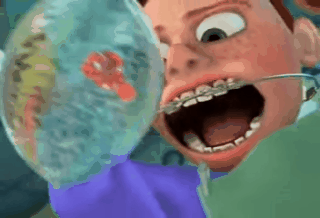

His appearance is modeled after the voice actor who does his voice, especially the coloring around his mouth to show the deep wrinkles that Dafoe has on his face. He had made several escape attempts, but the first time, he landed on dental tools, giving him severe scars on his right side, and destroying his right fin. Gill's only dream is to escape from the tank. In the Japanese dub from the movie, he was voiced by Kazuhiro Yamaji.

He was voiced by Willem Dafoe who had played Marcus in John Wick. Some time after Nemo is finally reunited with his father, Gill and the others from the tank are shown to have escaped and are swimming happily in the ocean. Nemo faked dying, and after a matter of crazy things happening, Gill catapulted him into a drain and was never seen by Darla again. When the plan unfortunately failed, almost resulting in Nemo getting killed, they thought of a better one the next day when there was a special fish tank system put in place. He is the mastermind behind the plan of getting Nemo and the others in the tank to escape by stopping the rotating machine with a pebble. He is the leader of the Tank Gang and a close friend with Nemo, whom he met at the dentist's fishtank in Sydney, Australia. Gill is a major character in Finding Nemo, and makes a minor return in the sequel, Finding Dory. ~ Gill explaining his plan to help Nemo escape the tank. In retrospect, the producers at Disney probably made the right call.We're gonna get him outta here. He would become his own father while his father became his mother, and they would raise little incestuous Nemos together without a drip of sentimentality.

Nemo (the only other fish remaining in the anemone) would rapidly develop mature gonads. He would simply become Nemo’s new mother. Finding Nemo painted a simple picture for more than just the sake of simplicity: a real clownfish father who lost his mate would not develop a psychologically complex system of grieving and overprotection. A simply hierarchy of size and strength determines the family’s whole structure, conflicting with the acceptable social norms for children’s movies. If the matriarch dies, the fertile male who was #2 now takes her place as #1, metamorphosing into a female himself. One of the mated pair will eventually die, to be swiftly replaced by someone down the ladder. The others bide their time, defending the anemone and the family’s precious eggs. The largest and most dominant male turns into a female the next-largest develops functioning testes. A handful of fish share each anemone, all beginning their lives as immature males. The film supposes a lifelong romance for Nemo’s parents, but genuine clownfish live only as part of larger groups. Like a wild card, it’s only good once: once males turn into females, they can’t turn back into males. All are born male, with the ability to change sex. As sequential hermaphrodites, they lead unique home lives. Finding Nemo gets many things right-the anxiety of leaving home and the obnoxious yelping of seagulls-but it punts away the most fascinating aspect of clownfish. The eponymous clownfish vanishes from his home anemone, forcing his widowed father to take off after him. The 2003 Disney film Finding Nemo formally canonized the anemone dweller’s adorability. Had Pixar stayed true to clownfish biology, they would have ended up with a quite different story: Palumbi’s new book The Extreme Life of the Sea, Finding Nemo director Andrew Stanton bypassed the most intriguing trait of clownfish, which is that they can change their sex. But according to this fascinating excerpt from Stephen R. Pixar’s Finding Nemo told of a touching bond between a clownfish father and son.


 0 kommentar(er)
0 kommentar(er)
